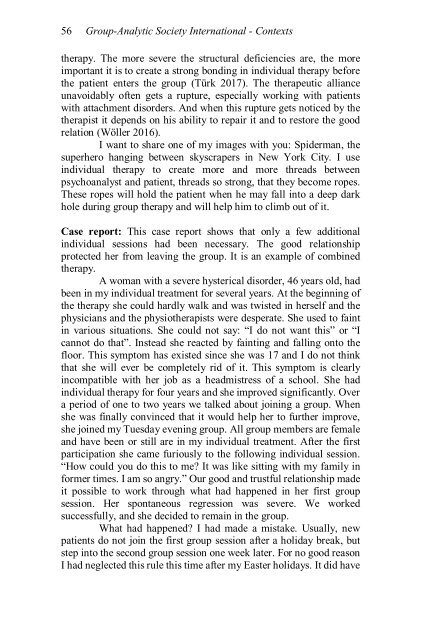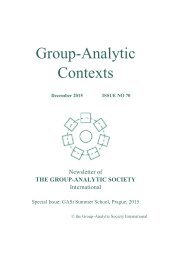Group-Analytic Contexts, Issue 80, June 2018
You also want an ePaper? Increase the reach of your titles
YUMPU automatically turns print PDFs into web optimized ePapers that Google loves.
56 <strong>Group</strong>-<strong>Analytic</strong> Society International - <strong>Contexts</strong><br />
therapy. The more severe the structural deficiencies are, the more<br />
important it is to create a strong bonding in individual therapy before<br />
the patient enters the group (Türk 2017). The therapeutic alliance<br />
unavoidably often gets a rupture, especially working with patients<br />
with attachment disorders. And when this rupture gets noticed by the<br />
therapist it depends on his ability to repair it and to restore the good<br />
relation (Wöller 2016).<br />
I want to share one of my images with you: Spiderman, the<br />
superhero hanging between skyscrapers in New York City. I use<br />
individual therapy to create more and more threads between<br />
psychoanalyst and patient, threads so strong, that they become ropes.<br />
These ropes will hold the patient when he may fall into a deep dark<br />
hole during group therapy and will help him to climb out of it.<br />
Case report: This case report shows that only a few additional<br />
individual sessions had been necessary. The good relationship<br />
protected her from leaving the group. It is an example of combined<br />
therapy.<br />
A woman with a severe hysterical disorder, 46 years old, had<br />
been in my individual treatment for several years. At the beginning of<br />
the therapy she could hardly walk and was twisted in herself and the<br />
physicians and the physiotherapists were desperate. She used to faint<br />
in various situations. She could not say: “I do not want this” or “I<br />
cannot do that”. Instead she reacted by fainting and falling onto the<br />
floor. This symptom has existed since she was 17 and I do not think<br />
that she will ever be completely rid of it. This symptom is clearly<br />
incompatible with her job as a headmistress of a school. She had<br />
individual therapy for four years and she improved significantly. Over<br />
a period of one to two years we talked about joining a group. When<br />
she was finally convinced that it would help her to further improve,<br />
she joined my Tuesday evening group. All group members are female<br />
and have been or still are in my individual treatment. After the first<br />
participation she came furiously to the following individual session.<br />
“How could you do this to me? It was like sitting with my family in<br />
former times. I am so angry.” Our good and trustful relationship made<br />
it possible to work through what had happened in her first group<br />
session. Her spontaneous regression was severe. We worked<br />
successfully, and she decided to remain in the group.<br />
What had happened? I had made a mistake. Usually, new<br />
patients do not join the first group session after a holiday break, but<br />
step into the second group session one week later. For no good reason<br />
I had neglected this rule this time after my Easter holidays. It did have













